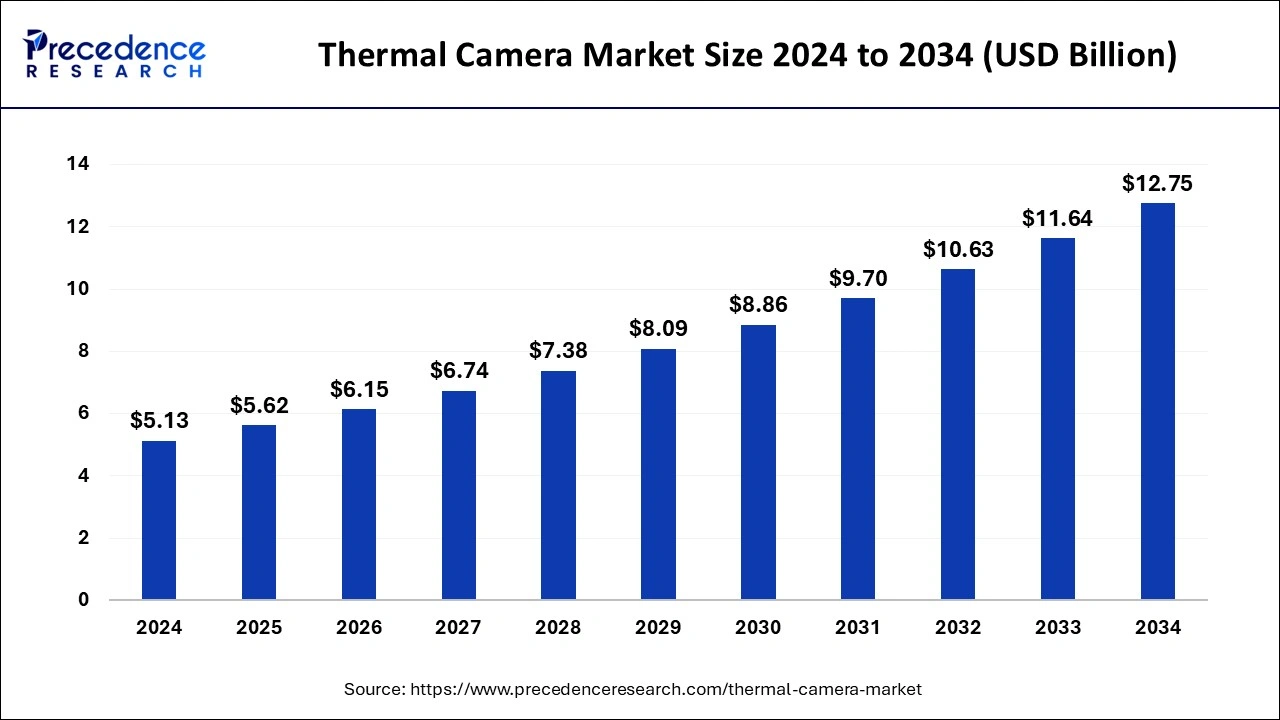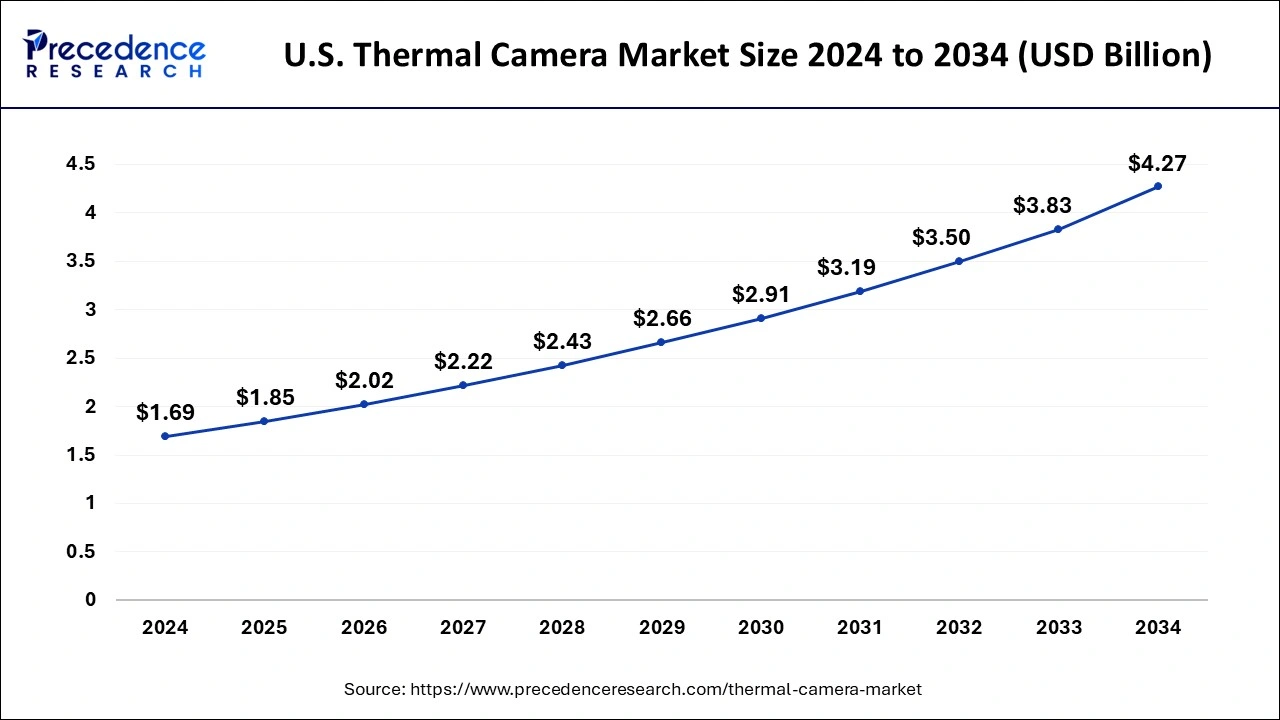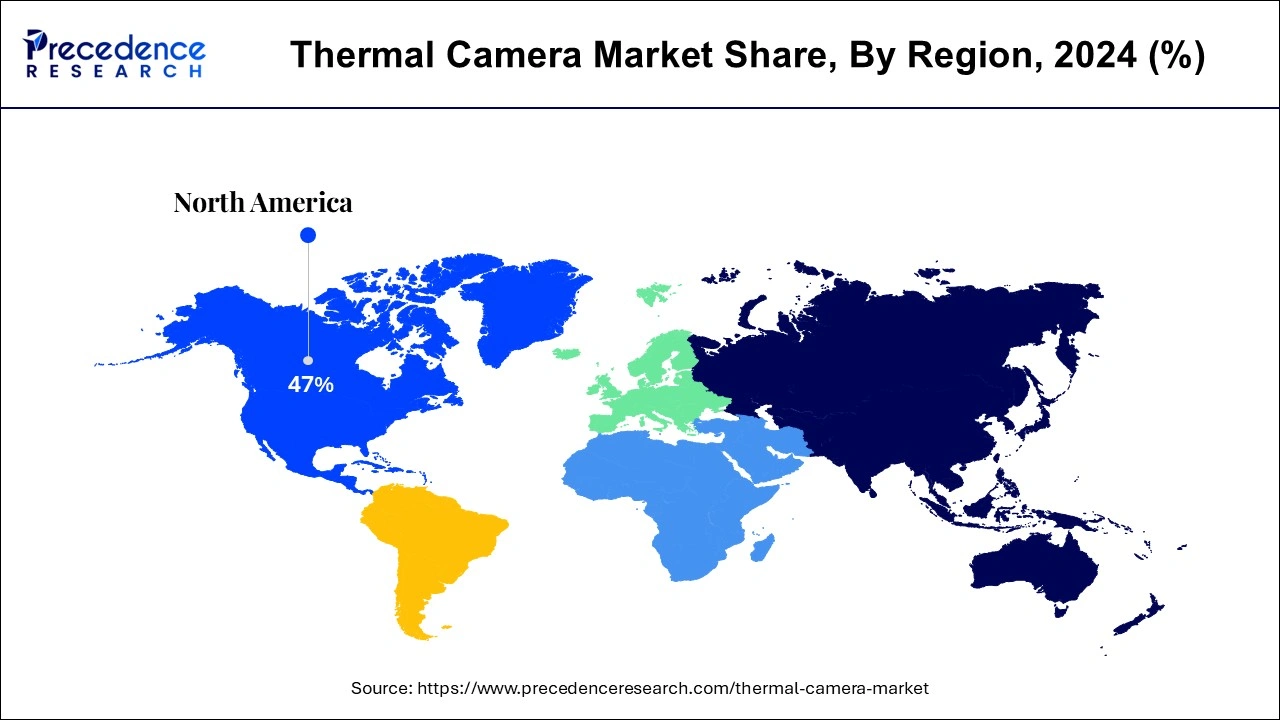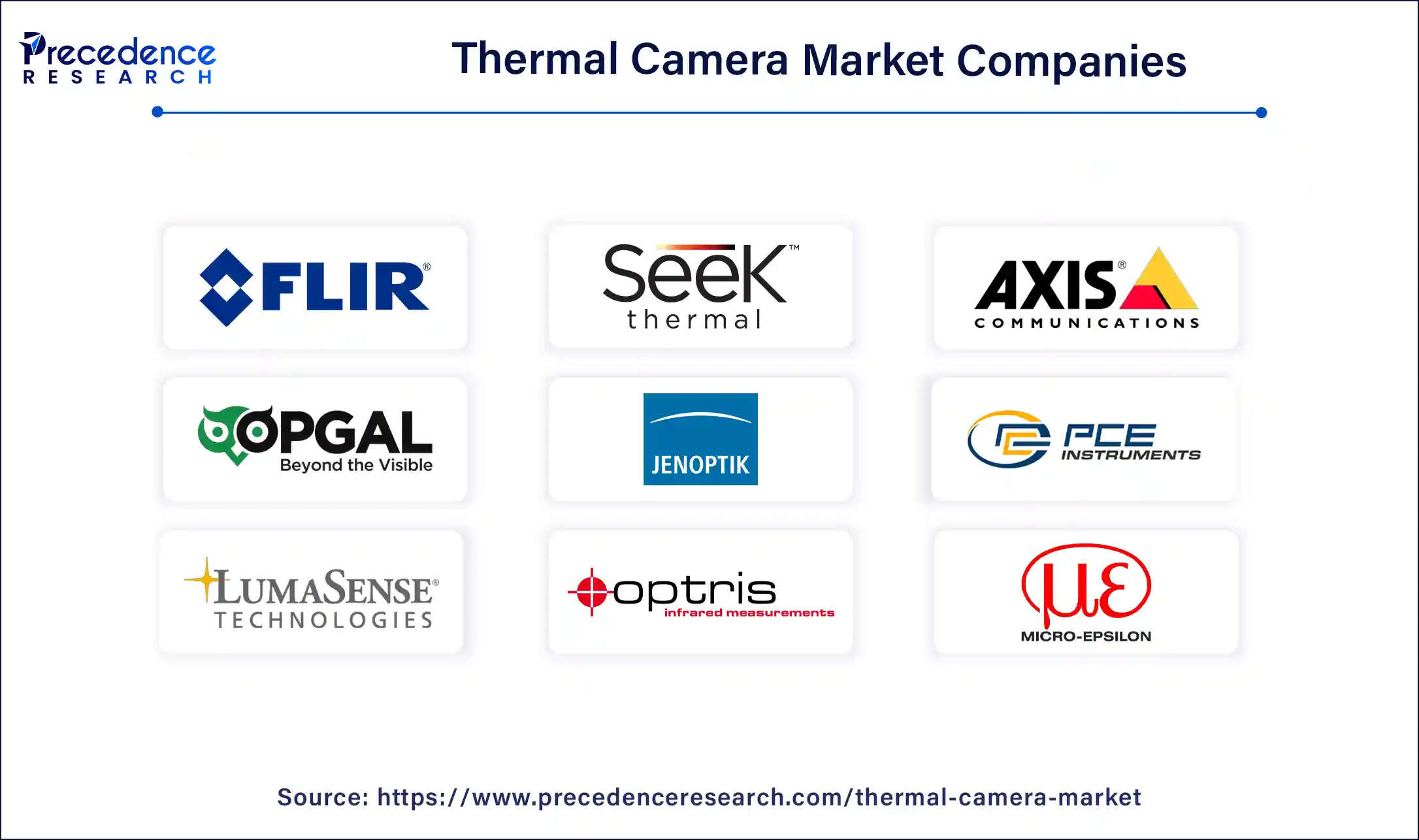Thermal Camera Market Size and Forecast 2025 to 2034
The global thermal camera market size was estimated at USD 5.13 billion in 2024 and is anticipated to reach around USD 12.75 billion by 2034, expanding at a CAGR of 9.53% from 2025 to 2034. Similar to a regular camera, which creates photos using visible light, a thermal imaging camera aids in the production of photographs utilizing infrared radiation. Numerous industries, including autonomous cars, skin temperature monitoring, firefighting, military and defense, infrastructure, and structures, employ thermal imaging extensively.

Thermal Camera Market Key Takeaways
- North America dominated the global thermal camera market with the largest market share of 47% in 2024.
- Asia Pacific is projected to expand at the notable CAGR during the forecast period.
- By technology, the cooled segment contributed the highest market share in 2024.
- By end-user, the military and defense segment has held the largest market share in 2024.
The Impact of AI in the Thermal Camera Market
AI is revolutionizing the thermal camera market by focusing on digital interpretation of visual data as images and videos. With the integration of deep learning algorithms as convolutional neural networks, the models have become highly efficient and able to extract the most relevant features for each task on their own. The AI algorithms also help to save time along with, help to find relevant information, pattern that can be ignored by human detection. On account of this, many developers have been creating AI solutions that are fed with thermal images. Some of these applications are for material recognition, human detection, automatic guidance for firefighters, fever detection and carpal tunnel syndrome diagnosis.
U.S. Thermal Camera Market Size and Growth 2025 to 2034
The U.S. thermal camera market size was evaluated at USD 1.69 billion in 2024 and is predicted to be worth around USD 4.27 billion by 2034, rising at a CAGR of 9.71% from 2025 to 2034.

North America is anticipated to lead this market share due to the rising need for thermal imaging technology in the manufacturing as well as commercial sectors. Additionally, the military and defense sector's booming need for these cameras for the purpose of security and surveillance applications is anticipated to have a beneficial influence on the market's expansion in North America. IoT and improved thermal imaging solutions are being implemented more slowly than initially anticipated, withsemiconductorbusinesses stepping in to assist advance other new imaging technologies. The technical potential of thermal technology, including its capacity to collect and analyze enormous amounts of industrial data, is the focus of developers and business leaders in the region. This data may be used to manage industrial safety and compliance while enhancing protection, monetary returns, and convenience.

The second-largest market share belongs to Europe. This region's market is expected to grow as defense & monitoring need rises. The demand in this area has also been greatly influenced by the progressive fall of thermal cameras in addition to the inexpensive availability of thermal sensors. Additionally, nations like France, the United Kingdom, and Italy are increasing their military spending, making up a significant portion of the market. Due to the escalating border conflicts between nations like India and China, the Asia-Pacific market is predicted to have exceptional growth. Countries are being forced by these wars to increase their military spending and provide their armed forces with cutting-edge monitoring equipment like thermal cameras.
Thermal Camera Market Growth Factor
- Increasing demand for surveillance across various industries like mining, oil and gas.
- Development of high-speed technology is also propelling the thermal camera market.
- Its ability to efficiently work in adverse conditions.
- Increased use of IR or thermal imaging techniques in military operations that allows high resolution vision even in darkness.
- Thermal cameras can also detect human targets, vehicles which emit enough heat radiation, thus, can be used in rescue operations.
Market Scope
| Report Coverage | Details |
| Market Size in 2025 | USD 5.62 Billion |
| Market Size by 2034 | USD 12.75 Billion |
| Growth Rate from 2025 to 2034 | CAGR of 9.53% |
| Base Year | 2024 |
| Forecast Period | 2025 to 2034 |
| Largest Market | North America |
| Segments Covered | By Product, By Technology, By End Use |
| Regions Covered | North America, Europe, Asia-Pacific, Latin America, Middle East & Africa |
Market Dynamics
Key Market Drivers
- Demand for thermal camera in various applications - On the other hand, commercial use of thermal imaging cameras is growing, and over the next few years, the worldwide market is anticipated to grow dramatically. A few applications for thermal cameras and detectors include home automation, security, fire detection, and gas detection. Although they were first created for military applications, thermal cameras are now increasingly utilized in non-military settings. More people are using robust thermal cameras in healthcare, which might result in profitable growth opportunities. Since then, a wider variety of medical applications have used thermal imaging cameras. One of the most popular uses of thermography is the detection of breast pathologies, such as breast cancer, fibrocystic breast disease, and mastitis.
Key Market Challenges
- High cost associated with thermal cameras -Although thermal imaging technology is safe and silent, it has several drawbacks similar to other technologies. The price of these cameras is preventing wider use. Because they are temperature-based, these devices are affected by the weather, and the visual contrast is minimal. The primary barrier to the widespread use of infrared thermal imaging systems is still their high cost, but because to the development of non-cooled infrared plane arrays, they may now offer good resolution and efficiency at reasonable costs. Potential costs of thermal cameras may be significantly decreased by the progress of innovations, breakthroughs in core advancements, and growth in manufacturing performance.
Key Market Opportunities
- Oil & gas companies use thermal imaging to find pipeline leaks -The oil & gas industry faces a variety of maintenance issues, including valves, turbines, generators, and pipe failures that result in harmful emissions and dangerous gas spills into the atmosphere. Detecting invisible oil & gas leaks takes a lot of time and effort when using traditional inspection techniques, especially when there are many components to check. In the oil & gas sector, thermal cameras are frequently employed as tools for preventative maintenance to identify leaks in installations, pipelines, and reservoirs. As a result, they increase protection and pollution levels with a lower risk of disruption as a result of regulatory bodies' actions. The quicker leak detection and immediate source identification made possible by these cameras results in quicker repairs, lower industrial emissions, and greater regulatory compliance. For the oil and gas industry, a number of significant market participants are launching a wide range of these devices. In the upcoming years, these elements are anticipated to propel the thermal camera market.
- Technical advances and R&D activities -Due to increasing R&D investment by key industry participants and a larger emphasis on incorporating cutting-edge technologies, the market for thermal imaging cameras has a bright future. Revenue growth in the thermal camera market is anticipated as surveillance technology develops and the security & surveillance industry expands. As thermal imaging technology is used more often for perimeter security and as the price of thermal imaging equipment drops, the market for thermal imaging cameras will grow. The automobile industry's growing acceptance of thermal imaging as well as favorable government initiatives and regulations are expected to boost the market for thermal cameras.
Product Insights
Because of its wider range of uses, including thermal imaging, medical imaging, predictive maintenance, and other areas, the portable thermal camera market is anticipated to develop at the greatest rate over the projected period. The demand for these cameras has also increased as a result of the growing need for these devices to detect body temperature and also for other healthcare-related applications. Mount thermal camera devices are essential in smoke detection & protection, early fire warning, and surveillance applications, in addition to being utilized to boost manufacturing productivity or optimize quality assurance.
Technology Insights
The market's largest share will be accounted for by the cooled thermal camera segment. During the forecast period, thermal imaging systems with cooled detectors are anticipated to see rapid acceptance, primarily because of their quick capture rate as well as the broad thermal isolation band. Additionally, because they use shorter infrared wavelengths for sensing, cooled cameras typically have larger magnification capabilities. Since cooled cameras have higher resistance qualities, they can be used with lenses that have more optical elements or thicker components without lowering the signal-to-noise ratio.
End Use Insights
The military and defense segment has held the largest market share in 2024. The industry segment with the highest CAGR will be healthcare as well as life sciences. Thermal cameras are being used by many researchers as well as healthcare organizations all over the world to monitor and capture variations in body temperature for diagnostic reasons. Researchers get information on metabolic and circulatory functioning through the analysis of thermal pictures taken by cameras in order to spot abnormal physical changes.
These tools are also used to look at a wide range of illnesses where the skin's temperature may reveal inflammation or injury to the tissues, or if blood flow is altered due to a clinical deformity. Also most clinicians today use thermal imaging equipment to identify a wide range of medical issues, including circulatory abnormalities, arthritis, recurring strain injuries, and body aches.
Thermal Camera Market Companies

- FLIR Systems Inc.
- Seek Thermal
- Axis Communications AB
- Opgal Optronic Industries Ltd.
- Jenoptik AG
- Fluke Corporation
- PCE Instruments
- Mobotix AG
- LumaSense Technologies Inc.
- Spectronic Plc.
- Optris GmbH
- Schneider Electric SE
- DIAS Infrared GmbH
- InfraTec GmbH
- Ulirvision Technology Co. Ltd.
- HikVision Digital Technology Co.
- Micro-Epsilon
- Caterpillar Inc.
- Bullit Mobile Ltd.
- 3M Scott
Latest industrial announcements
- In May 2024, A leading player in defense technology, named as Teledyne FLIR LLC, unveiled the system known as the rouge 1 loitering munition system and showcased its capacities at the Tampa, during special operations forces week.
Recent developments
- In Janurary 2025, TOPDON US announced the launch of TS005, a professional-grade thermal monocular camera for use in covert operations. The camera includes world-class technology with increased heat range and accuracy while using nighttime vision. The camera provides clear vision up to 1200 meters and includes a built-in laser to locate targets up to 600 meters even in extreme weather conditions such as rain, snow, and fog. The camera has applications in law enforcement, emergency medical services, disaster relief, and game wardens.
- In February 2024, center for development of advanced computing (C-DAC), Prama India and ministry of electronics and information technology government of India, have collaborated technologically for thermal cameras. It is considered as a significant step towards supporting innovations and domestic manufacturing. The collaboration was intended to further research and development into innovative thermal technology applications. C-DAC announced the 'Digital India FutureLabs' initiative at IITM, New Delhi with the aim to undertake this research.
Segment Covered in the Report
By Product
- Handheld
- Fixed/Mounted
By Technology
- Uncooled
- Cooled
By End Use
- Military and Defense
- Industrial
- Commercial
- Healthcare and Lifescienes
- Residential
- Automotive
- Oil and Gas
By Geography
- North America
- Europe
- Asia-Pacific
- Latin America
- Middle East & Africa (MEA)
For inquiries regarding discounts, bulk purchases, or customization requests, please contact us at sales@precedenceresearch.com
Frequently Asked Questions
Ask For Sample
No cookie-cutter, only authentic analysis – take the 1st step to become a Precedence Research client
 sales@precedenceresearch.com
sales@precedenceresearch.com
 +1 804-441-9344
+1 804-441-9344